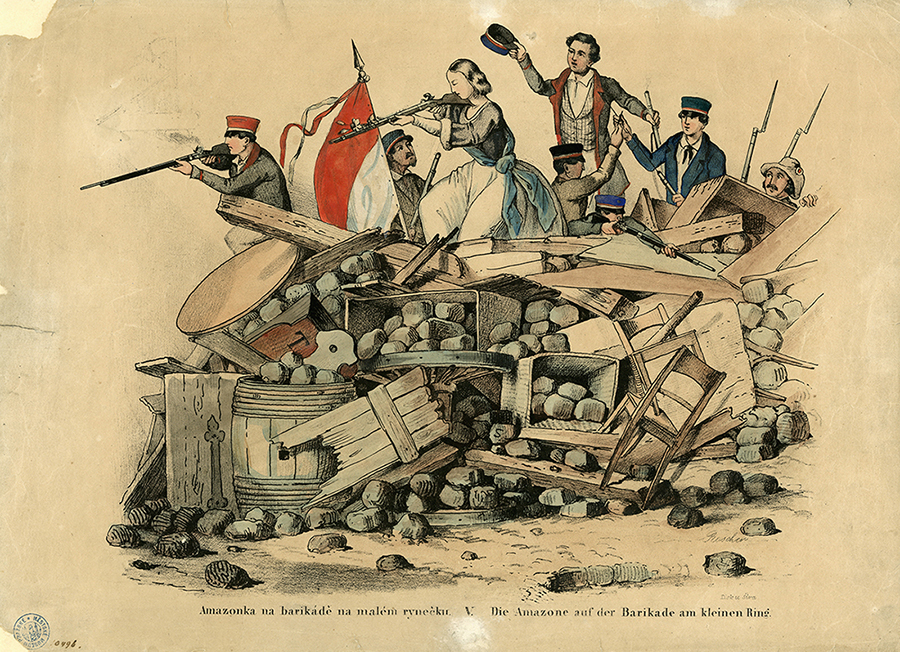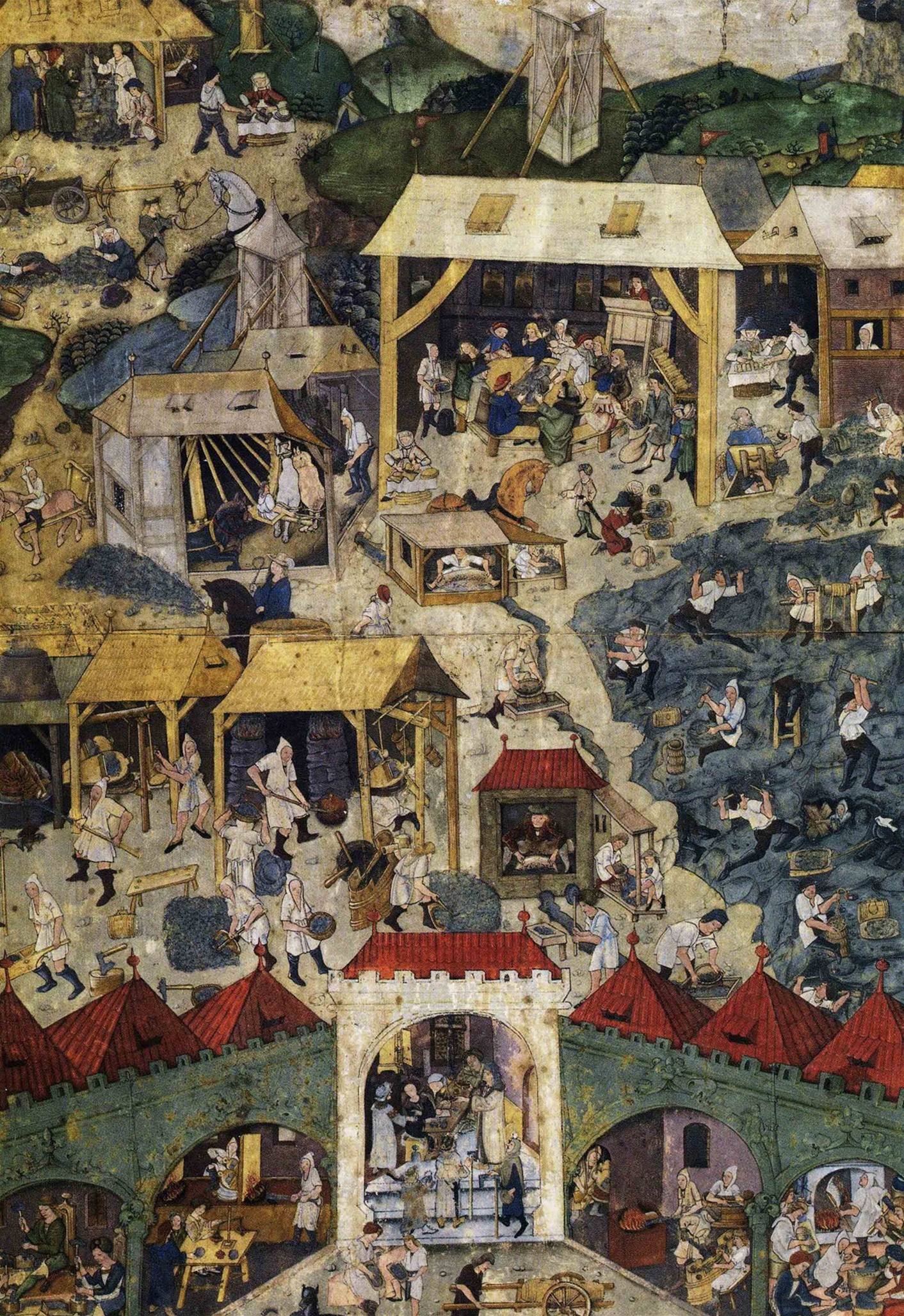|
Prague Uprising Of 1848
The Prague Uprising of 1848 ( cs, Pražské červnové povstání), also known as the Pentecostal Storm, was an armed conflict on 12-17 June 1848 in Prague, which culminated in the revolutionary process in the Czech lands. The uprising was a spontaneous unprepared uprising, which was suppressed by the army and killed about 43 people. Background From March 11, 1848 (Assembly in Svatováclavské lázně) there was a political unrest in Prague, by which Prague joined the wider revolutionary current in the whole of Europe. At that time, Czech politics had already split into a liberal current (František Palacký, Karel Havlíček Borovský) and a radically democratic one (Karel Sabina, Josef Václav Frič, Vincenc Vávra Haštalský, Vilém Gauč, Emanuel Arnold). In the first phase, the moderate liberals prevailed. They preferred constructive and cautious steps, such as the establishment of the St. Wenceslas Committee on March 12. On 19 and 31 March, the Committee prepared two p ... [...More Info...] [...Related Items...] OR: [Wikipedia] [Google] [Baidu] |
Revolutions Of 1848 In The Austrian Empire
The Revolutions of 1848 in the Austrian Empire were a set of revolutions that took place in the Austrian Empire from March 1848 to November 1849. Much of the revolutionary activity had a nationalist character: the Empire, ruled from Vienna, included ethnic Germans, Hungarians, Slovenes, Poles, Czechs, Slovaks, Ruthenians (Ukrainians), Romanians, Croats, Venetians and Serbs; all of whom attempted in the course of the revolution to either achieve autonomy, independence, or even hegemony over other nationalities. The nationalist picture was further complicated by the simultaneous events in the German states, which moved toward greater German national unity. Besides these nationalists, liberal and even socialist currents resisted the Empire's longstanding conservatism. Preamble The events of 1848 were the product of mounting social and political tensions after the Congress of Vienna of 1815. During the "pre-March" period, the already conservative Austrian Empire moved further aw ... [...More Info...] [...Related Items...] OR: [Wikipedia] [Google] [Baidu] |
Lev Thun
Leopold Graf von Thun und Hohenstein (7 April 181117 December 1888) was a leading Austrian statesman from the Thun und Hohenstein family. Early life He was born in Děčín (Tetschen) as the third son of Count Franz von Thun und Hohenstein. After studying law and philosophy at the University of Prague he traveled through Europe, and among other countries he visited England, where he became acquainted with James Hope-Scott and other leaders of the Tractarian party. He was much affected by the romantic movement and the Ultramontane revival. In 1847 he married a Countess Clam-Martinic, but there was no issue of the marriage. Bohemian nationalist After his return home interested himself greatly in the revival of Czech language and Czech literature and the growth of Bohemian nationalism. He formed a personal friendship with František Palacký and other Czech leaders. He helped in the foundation of schools in which Czech should be taught, and set himself to acquire some knowled ... [...More Info...] [...Related Items...] OR: [Wikipedia] [Google] [Baidu] |
Klementinum
The Clementinum (''Klementinum'' in Czech) is a historic complex of buildings in Prague. Until recently the complex hosted the National, University and Technical libraries; the City Library was also nearby on Mariánské Náměstí. In 2009, the Technical library and the Municipal library moved to the Prague National Technical Library at Technická 6. It is in use as the National Library of the Czech Republic. In 2005, the Czech National Library received the UNESCO Jikji prize (Memory of the World). History Its history dates from the existence of a chapel dedicated to Saint Clement in the 11th century. A Dominican monastery was founded in the medieval period, which was transformed in 1556 to a Jesuit college. In 1622 the Jesuits transferred the library of Charles University to the Klementinum, and the college was merged with the University in 1654. The Jesuits remained until their suppression in 1773, when the Klementinum was established as an observatory, library, and uni ... [...More Info...] [...Related Items...] OR: [Wikipedia] [Google] [Baidu] |
Jan Arnold
Jan, JaN or JAN may refer to: Acronyms * Jackson, Mississippi (Amtrak station), US, Amtrak station code JAN * Jackson-Evers International Airport, Mississippi, US, IATA code * Jabhat al-Nusra (JaN), a Syrian militant group * Japanese Article Number, a barcode standard compatible with EAN * Japanese Accepted Name, a Japanese nonproprietary drug name * Job Accommodation Network, US, for people with disabilities * ''Joint Army-Navy'', US standards for electronic color codes, etc. * ''Journal of Advanced Nursing'' Personal name * Jan (name), male variant of ''John'', female shortened form of ''Janet'' and ''Janice'' * Jan (Persian name), Persian word meaning 'life', 'soul', 'dear'; also used as a name * Ran (surname), romanized from Mandarin as Jan in Wade–Giles * Ján, Slovak name Other uses * January, as an abbreviation for the first month of the year in the Gregorian calendar * Jan (cards), a term in some card games when a player loses without taking any tricks or scoring a mini ... [...More Info...] [...Related Items...] OR: [Wikipedia] [Google] [Baidu] |
Amazonka Na Barikádě, Praha 1848
''Amazonka'' ( uk, Амазонка; en, Amazon) is the sixth studio album by Ruslana. The album was released in Eastern Europe, Germany, China and other countries. The album is based on the book ''Wild Energy. Lana''. In the book, Lana breaks free from the normal cycle of an energy-efficient-gone-wrong future life. Each track is in order to the chapters of the book, conveying the different emotions in what the character and co-characters feel. Ruslana's music has turned to a new electronic/futuristic feel, in keeping with the setting of the book. About the album The people who created this album tend to characterize its original style as pop-fantasy. It's based on hurricane music chapters – the ones which conjure up pictures of fights between Tolkien's orcs and confrontation of Elements of Nature in Carpathians. Lightning, thunderstorm, hurricanes and industrial sounds of terrific fantastic plant – they are regular instruments in songs of "Amazon". But despite the above, th ... [...More Info...] [...Related Items...] OR: [Wikipedia] [Google] [Baidu] |
Wenceslas Square
Wenceslas Square (Czech: , colloquially ''Václavák'' ) is one of the main city squares and the centre of the business and cultural communities in the New Town of Prague, Czech Republic. Many historical events occurred there, and it is a traditional setting for demonstrations, celebrations, and other public gatherings. It is also the place with the busiest pedestrian traffic in the whole country. The square is named after Saint Wenceslas, the patron saint of Bohemia. It is part of the historic centre of Prague, a World Heritage Site. Formerly known as Koňský trh (''Horse Market''), for its periodic accommodation of horse markets during the Middle Ages, it was renamed Svatováclavské náměstí (English: ''Saint Wenceslas square'') in 1848 on the proposal of Karel Havlíček Borovský. Features Less a square than a boulevard, Wenceslas Square has the shape of a very long (750 m, total area 45,000 m2) rectangle, in a northwest–southeast direction. The street ... [...More Info...] [...Related Items...] OR: [Wikipedia] [Google] [Baidu] |
Karolinum
Karolinum (formerly Latin: ''Collegium Carolinum'', in Czech ''Karlova kolej'') is a complex of buildings located in the Old Town of the City of Prague. Karolinum, the seat of the Charles University, is one of the oldest dormitories situated in Central Europe. The dormitory was named after the Emperor Charles IV. History Shortly after the establishment of Charles University in 1348, the young institution encountered several organizational problems. One of the major complications was the lack of lecture and accommodation rooms for teachers and students. Emperor Charles IV, apparently inspired by the organization of the Sorbonne college in Paris and by the newly founded universities in Kraków (1364) and Vienna (1365), decided to donate to the school a new college. In 1366, the university received the house of the Jew Lazar, located in the Prague's Old Town. However, the school was donated really representative rooms only in the early 1380s by Wenceslaus, the son of Charles IV. F ... [...More Info...] [...Related Items...] OR: [Wikipedia] [Google] [Baidu] |
Hradec Králové
Hradec Králové (; german: Königgrätz) is a city of the Czech Republic. It has about 91,000 inhabitants. It is the capital of the Hradec Králové Region. The historic centre of Hradec Králové is well preserved and is protected by law as an Cultural monument (Czech Republic)#Monument reservations, urban monument reservation, the wider centre is protected as an Cultural monument (Czech Republic)#Monument zones, urban monument zone. Administrative parts Hradec Králové is made up of 21 city parts: *Březhrad *Hradec Králové *Nový Hradec Králové *Kukleny *Malšova Lhota *Malšovice *Moravské Předměstí *Piletice *Plácky *Plačice *Plotiště nad Labem *Pouchov *Pražské Předměstí *Roudnička *Rusek *Slatina *Slezské Předměstí *Svinary *Svobodné Dvory *Třebeš *Věkoše Etymology The city was originally named Hradec, which is a diminutive of ''hrad'' (i.e. "castle"). Later, when it was owned by Bohemian queens, the Králové attribute (from ''král, král ... [...More Info...] [...Related Items...] OR: [Wikipedia] [Google] [Baidu] |
Kutná Hora
Kutná Hora (; medieval Czech: ''Hory Kutné''; german: Kuttenberg) is a town in the Central Bohemian Region of the Czech Republic. It has about 20,000 inhabitants. The centre of Kutná Hora, including the Sedlec Abbey and its ossuary, was designated a UNESCO World Heritage Site in 1995 because of its outstanding architecture and its influence on subsequent architectural developments in other Central European city centres. Since 1961, the town centre is also protected by law as an urban monument reservation, the fourth largest in the country. Administrative parts The town is made up of twelve town parts and villages: *Kutná Hora-Vnitřní Město *Hlouška *Kaňk *Karlov *Malín *Neškaredice *Perštejnec *Poličany *Sedlec *Šipší *Vrchlice *Žižkov Geography Kutná Hora is located about east of Prague. It lies on the Vrchlice stream. The eastern part of the municipal territory lies in a flat agricultural landscape of the Central Elbe Table lowland. The western part lies i ... [...More Info...] [...Related Items...] OR: [Wikipedia] [Google] [Baidu] |

.jpg)


